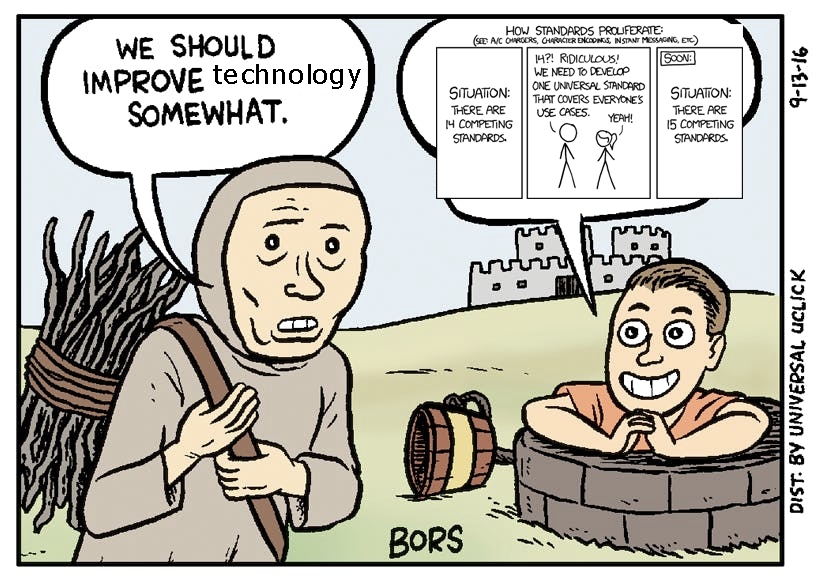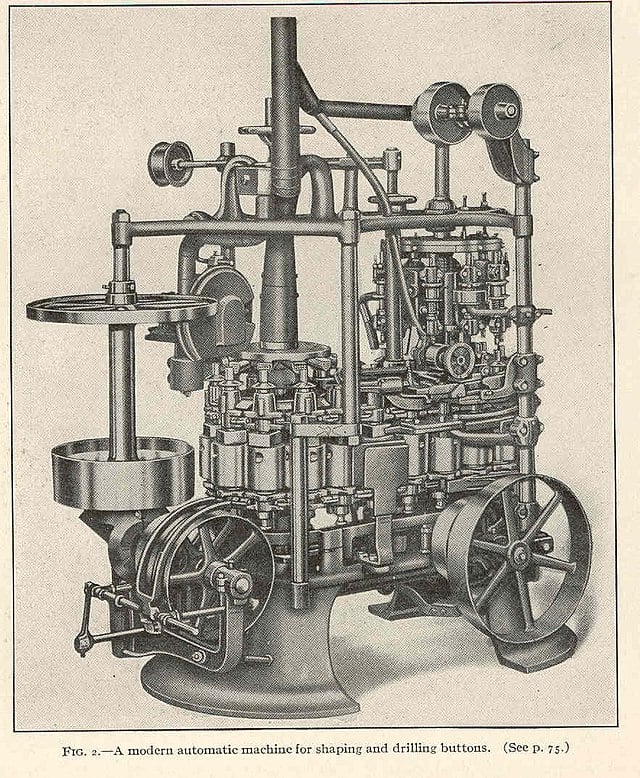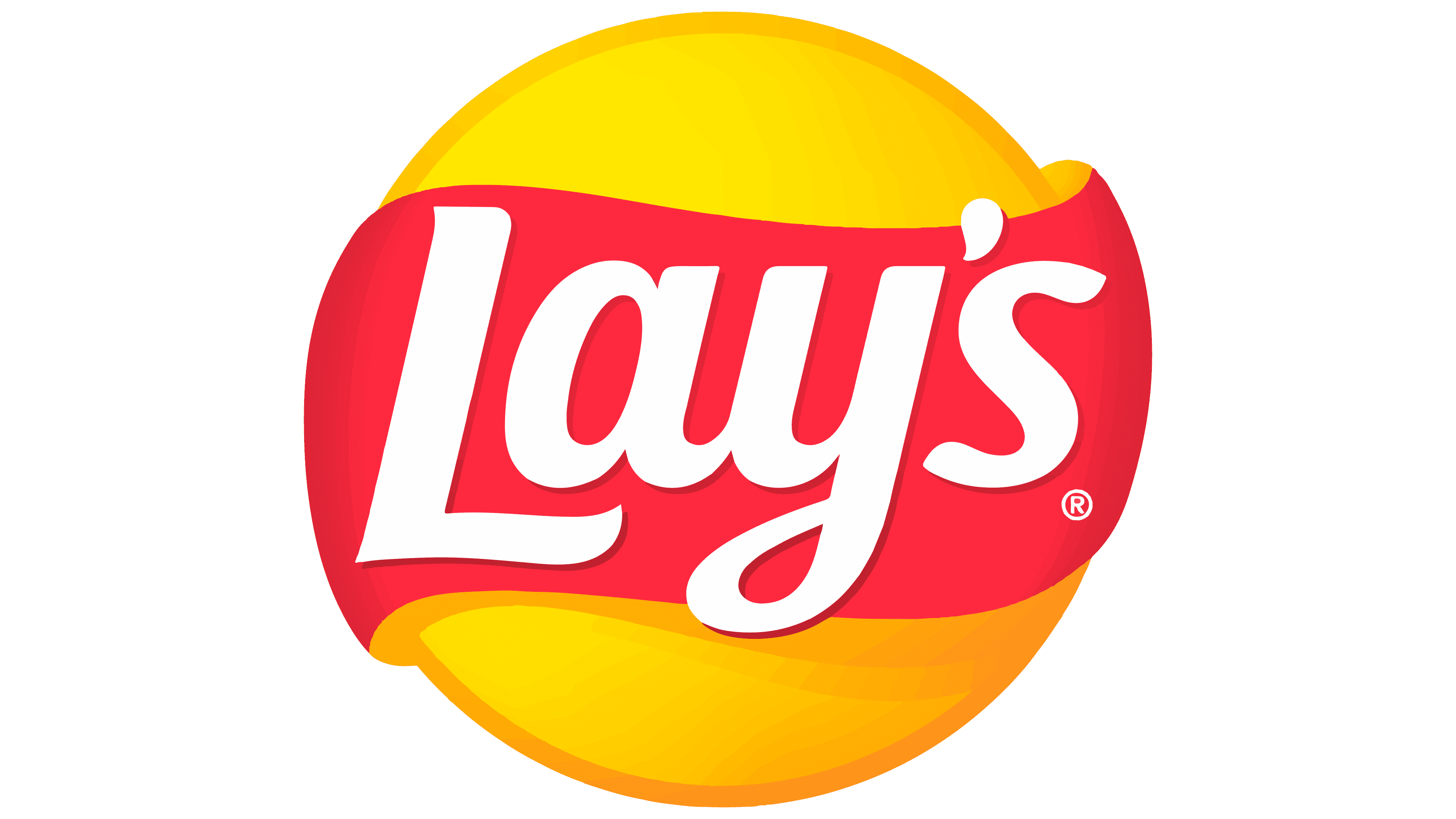MIDI.
Before the 80’s, there was no standard interface to control electronic instruments, just a bunch of proprietary interfaces unique to each manufacterer. But in 1983, amazingly they actually standardized on MIDI, and it remains a useful standard to this day, with any new versions of MIDI being completely backwards compatible, so your Yamaha DX7 from the 80’s is still just as viable to use today as the day it was new!
DMX is a similar protocol for lighting.
Sure, there’s artnet and sacn, but most gigs still use good old DMX.I hate to tell you this but DMX passed away in 2021
This really is a perfect example. I did a lot of MIDI things as a kid!
Should mention Open Sound Control which is also pretty good. Not exactly a competitor, it was supposed to provide a richer, real time interface. Still popular for certain use cases, including beyond music.

There are many, I think. Like what other people have mentioned, sometimes the new standard is just better on all metrics.
Another common example is when someone creates something as a passion project, rather than expecting it to get used widely. It’s especially frustrating for me when I see people denigrate projects like those, criticizing it for a lack of practicality…
The competing standards problem is mostly a problem of not actually talking to stakeholders. Most of these “universal standards” don’t cover some rare, specific, but very important, use cases.
Toilet paper rolls.
Somehow we settled on a pretty good size for toilet rolls, and there never seems to be a compatibility issue with holders.
At least not for households. Commercial products have their own things going on, but it doesn’t affect most people.
Is there a formal standard, or did we decide not to mess with good enough?
We’ve got a 100 year old toilet roll holder, the spindle was turned on a lathe and the wooden cutout it sits in was hand carved. It is a poor fit for modern high sheet count rolls. We can’t stand to get rid of it so we just leave the roll outside of it until it is small enough to fit.
I have a half-bath with a modern holder. When that roll is 75% consumed, I move it to the bathrooms with the older style.
I like how you roll.
When one roll is empty, have you considered rolling half of a new roll onto it?
That sounds like a lot of fiddly work. Just sit a new roll on the back of the tank and use it until it fits.
You’re a machinist! Can’t you just like…make a better one? /s
I actually have a wood lathe and all the other tooling to make one, not that I would.
I’ve been fixing the place up since August. It’s a farm that hasn’t been properly maintained in about 20 years.
I’m doing my best to build to the standard of the original owner and his son with modern materials and methods. It’s a humbling experience. Nothing is quite square but everything is built like it’s bomb proof. You couldn’t afford to build out of solid wood like they did. The joints and meets are also super tight, you can’t get a sheet of paper between roof boards on the barn in most places.
What’s the width like? Consistent with modern rolls, or no?
Correct, width is the same. It can’t handle the diameter of modern jumbo rolls.
You could always buy smaller rolls. Someone must, since they still exist
My girl makes that decision and wants to keep the holder as well.
This is a cool one I haven’t thought of before!
Whenever the new standard hits the almost impossible golden triangle of “cheap, reliable, and fast”.
It’s gotta be cheaper than the alternatives, better and more reliable than the alternatives, and faster/easier to adopt than the alternatives.
Early computers for example had various ways to chug math, such as mechanical setups, relays, vacuum tube’s, etc.
When Bell invented their MOSFET transistor and figured out how to scale production, all those previous methods became obsolete for computers because transistors were now cheaper, more reliable, and faster to adopt than their predecessors.
Tbf though transistors are more of a hardware thing. A better example of a standard would be RIP being superceded by BGP on the internet.
Tbf though transistors are more of a hardware thing. A better example of a standard would be RIP being superceded by BGP on the internet.
another big example is the telecom companies being superseded by IP based networking, rather than whatever patch routing bullshit was previously cooked up.
Sometimes certain solutions are just, better.
Light bulb sockets are the same all over. RJ-45 Ethernet, USB-C, Bluetooth, WiFi, TCP, HTTP, HTML, CSS.
While light bulb sockets don’t change much from region to region, they definitely aren’t all the same. For the bulbs (not the bars), there’s two large categories: Edison screws and bi-pin. Edison screws also come in a lot of sizes. When compact fluorescents were rolling out, they got a new bi-pin connector from the USA: GU24. My whole home has GU24 fixtures (not by my own choice), but my lamps are Edison screws.
GU24 is wack, especially for home lighting. I think they aren’t made much anymore.
It was a pain to find gu24, I had to order them online for two rooms
Thank you for teaching me how to replace my porch light (ONLY MY PORCH LIGHT?!?!) that’s been out for over a year. I tried to pull the bulb out and it shattered in my hands. I was like WTF is this shit? Haven’t touched it since.
Include car cigarette lighter power ports
USB-C
Gonna have to disagree with you there. Try using a USB-C data cable to charge a device. Now try figuring out which cable out of five is the charge cable.
Those aren’t different standards, they’re just different USB-C cables. It’s like saying light bulb sockets aren’t a unifying standard because there’s different bulbs with different wattages. The fact that all those cables work over the same standard is an example of how ubiquitous the standard is. That said they should be labeled better, like how USB3 was color coded blue; each cable could have a color strip to distinguish it.
Shouldn’t being able to identify which cable is used for which application be part of a standard?
You brought up light bulbs- imagine if they didn’t tell you the wattage? But they do. They print it right on the bulb.
I agree with you, but I don’t think that makes it a poor example; those different cables aren’t competing standards, they’re different types of USB-C cables. They should absolutely label the cables though, big oversight on the standard there.
It seems a lot of sites these days are actively hostile towards the HTML-CSS combo.
What do you mean? Do you have any examples?
Not really. I guess Google search requires JavaScript now.
HTML CSS and JavaScript each having different syntax is stupid and I will die on that hill.
Just use React or something, you can use a single syntax for all three. It makes total sense why the syntax is different if you think about when and why they were made. We had HTML for years before CSS, and it was longer still until we got JavaScript. Each language has a different purpose, so naturally a different syntax makes sense. Your hill is poorly defended.
In that case on general programming language should have taken over instead of trying to merge all three. Especially CSS, which in its infinite intelligence decided to use the minus operator instead of underscore, is completely out of place. Everything is jank and you can tell it has been patched together with duct tape.
Idk, I like CSS, but I come from a web development background. Modern JS (ES4+) is fully capable of replacing CSS using the style property.
JSX is sort of like a singular language to do all three.
HTML isn’t perfect, but I can’t think of a better language for writing documents. TEX is unintuitive, PDF is opaque, markdown is just HTML shorthand.
You can avoid the issue when a government just mandates one standard, ideally after consulting with experts on which is the best.
See: USB, SCART, etc.A lot of people seem to be opposed to this argument, seeing it as a kind of government overreach, but I think it can work if done correctly. Things like USB and HDMI are already governed by collectives of companies, I think having the government work together with them can be beneficial for both consumers and producers alike.
obligatory DisplayPort > HDMI
Cries in CEC.
Sometimes the regulators sit back and see how the market is pushing, then regulate it to reduce waste. EV chargers for example.
USB-C is a total failure though. Switching voltages, extremely high currents, expensive cables, fickle connectors, …
non standard conforming cables, and connectors, plus the entire mess of it supporting anything from power only, to usb 2, to usb 3, to thunderbolt 3, to thunderbolt 4? and usb 4.0 now.
It’s an utter fucking disaster of a shithole.
The way I see it, it’s not so much an issue of making something that’s better than the other standards. It’s really about getting your standard into actual use and hitting critical mass which makes all the other standards irrelevant.
see also: NACS (yep that’s a Tesla plug in a standards agreement)
Yeah. No standard covers all use cases. It’s just best to have one standard that makes a lot of compromises.
When the standard is a big interoperability push that leverages MORE functionality as a bribe to be implemented.
This is how USB (plug & play!), Bluetooth (wireless headset!), HDMI (high def, single cable!) , and USB-C (both sides are good!) all beat the entrenched pseudo standards.
Surprised I haven’t seen anyone here mention unicode
Probably because utf-8 vs utf-16 vs utf-32 makes people feel like it is still annoying multi-standard.
Networking standards started picking winners during the PC revolution of the 80’s and 90’s. Ethernet, with the first standards announced in 1983, ended up beating out pretty much other LAN standard at the physical layer (physical plugs, voltages and other ways of indicating signals) and the data link layer (the structure of a MAC address or an Ethernet frame). And this series of standards been improved many times over, with meta standards about how to deal with so many generations of standards through autonegotiation and backwards compatibility.
We generally expect Ethernet to just work, at the highest speeds the hardware is capable of supporting.
networking standards were a mess before ethernet really fucking cooked with twisted pair wiring.
Ethernet had already existed for a little bit prior to this, and most other alternatives were actively being worked on at the time, and relatively similar to ethernet, save for the general technical implementation, token ring as opposed to the funny broadcast meta. But when ethernet was able to just barely get ahead and use twisted pair, the entire thing came crumbling down and everyone agreed that ethernet over twisted pair, with switched star topology was the best.
What’d twisted pair bring to the table? Noise reduction?
three primary things.
Fucking coax, literally the bane of anybody anywhere, fucking horrible standard. Works well, which is the only reason anybody uses it, it’s just a nightmare. (if you have ever dealt with a coax cable, you know exactly what i mean)
Offices were already wired up with phone lines, which often had redundant lines running to each endpoint, meaning you could just hook straight into the existing wiring infrastructure, and convert it to ethernet (very accessible and cheap)
twisted pair comes with the advantage of noise reduction over longer distances, cheaper construction, and significantly simpler wire structure, making it easier to route, manage, terminate, and just generally exist around. (basically the same as the first one lmao)
It was actually so much of a problem, that the original ethernet standard, based on RG-6? I think, don’t quote me on it, ended up moving to a smaller coax standard and was referred to as “thinnet” as it was thinner coax and easier to work with.
UEFI boot mode
Anything by Sony
Not exactly this, but it reminds me of my first job. I used to work in finance, and I was given the task of automating cash flow reports that were sent out to hundreds of clients.
The problem was that they were made manually in Excel, and most of them were unique. So every couple years they’d get a bunch of smart people in a conference room, and tell them to figure out how to automate the cash flows. The first step was always to create a standard cash flow template, and convince everyone to adopt it.
Some users would adopt the new template, but most of them would say that the client didn’t like it, so they’d stop using it and the project would fall apart.
By the time I got there, there were still hundreds of unique cash flows, but then there were a few dozen that shared the same handful of templates, like a graveyard of failed attempts to automate this process.
I just made the output customizable. The reports looked the same as what the client was used to, but it saved hundreds of man hours for the users. A lot of people got laid off.
There are a lot and in most cases you’ll notice when dealing with Americans, who are refusing to do stuff like the rest of the world. The meter and kilogram took over from hundreds of different measurement standards. Most of the world is using the same calendar and writes dates in the same way. Most countries are driving on the same side. Traffic signs are kind of the same worldwide. You can buy screws with the same standard everywhere.
For home automation, Matter/Thread has the potential. We’ll see over the next five years, but yes market forces can make a new standard work
Reasons I’m hopeful
- this is the first time major companies are involved: Apple, Google, Amazon agree
- first time home automation hubs “just happen”, with the millions of people who have Echo, Google Home, Apple devices
- small companies that dominate home automation seem to realize the problem of the market can’t reasonably expand without interoperability and ease of use
Matter/Thread is the new kid on the block. Will it be yet another home automation standard, or will it gradually replace the previous ones? We’ll see.
Matter/Thread
i still think IP based smart home kit is a mistake. The internet is already such a big vuln, we don’t need a shit ton of garbage sitting on the network only making it more vulnerable.
communication standards like zwave, and zigbee, are preferable here. It looks like at least one of those supports it, but perhaps both will be protocol agnostic.
Think of Thread as Zigbee with an IPv6 stack. It’s a local communication standard but with a compatible protocol.
I was excited that my current phone has a Thread radio so it can be on the local network for presence and control. Unfortunately not supported yet.
I’m definitely worried about the recent Matter standard for internet access. They say it’s optional, but that capability is easily hijacked by unscrupulous vendors.
- my thermostat has cloud functionality that I want, so I’m fine with the option of giving them internet access
- my air purifier requires internet access to report back to a vendor-specific portal filled with advertising. I’m not ok with that tradeoff so don’t use any smart functionality.
it’s definitely cool that we have the capability of things like thread/matter zigbee and zwave now.
I would be more ok with local IoT devices being IP based if they were intended on being used with an “offline” network. Though that’s a little funky to setup, and causes interference issues, so i think i prefer the zigbee and zwave solution of using a different protocol entirely, especially since it mandates offline handling.
My two biggest concerns with IP connected devices are most home networks are not properly delegated, so people aren’t creating a second subnet specifically for IoT devices for example, and they most definitely aren’t properly providing access controls through that network as well. So if someone manages to get into one of the devices, you basically have the entire network at that point.
One of the big advantages of non IP based systems is that you have a “point of relay” or gateway between all of your IoT devices and your network, which becomes the attack vector, making it a lot easier to secure, and manage. Even if you managed to hack into a zwave/zigbee network, it would only be locally, and IoT devices only, so it’s not going to be hugely problematic.
theoretically you can do all of this on a traditional IP based network, i just don’t think it’s the correct approach. Sort of like making a carboat, or a boatcar. You could, but why?
I think at minimum, a standalone IoT device should not be capable of connecting to the global internet, period. Through something like a gateway or “point of relay” sure, that’s fine by me, but even then i would prefer open standards and documentation on that specific feature set.
You may be misunderstanding my description a bit. Think of Thread as Zigbee 2.0. It’s not, but that’s a useful way of thinking of it. It’s a_local_ mesh network just like Zigbee, even using the same frequency. The protocol stack is different: it’s IPv6 for capability, but completely separate from your Ethernet/wifi. There is no online requirement, at least from the standard.
Matter is Ethernet/WiFi based and can act as a gateway for Thread, but theirs is no online requirement, at least from the standard.
But yes, companies will ignorantly or willfully violate things like that. My most recent example is effing Netgear. I didn’t think I had to ask whether my new router’s “separate IoT network” was actually separate. I set up a different ssid, configured it to 2.4GHz only, separate password …. WTF, it’s on the same network with no separation? How is that even a useful thing?
My guess is that the speed with which new device types are supported is too slow to make it truly revolutionary. It was a good idea, it just does not happen fast enough to become dominant.
Definitely a problem - but the positive side of that is the slow pace is from reaching a consensus. It’s easy to be impatient with how slow the rollout is going but if that means that most manufacturers of each type are on board it could still be a good thing
Let’s hope so, I would love that! It is so frustrating shopping for new Home Assistant gear, finding something nice and then realizing it uses FlooSnorb instead of zigbee or wi-fi or bluetooth or whatever you already have. And yeah, sure, you can buy a controller for that, and there is probably an integration for that for HA, but damnit…another one? 😁 ™️
At this point i already support the most common protocols in HA, so i really hope for the end of WiFi, and vendor specific portals















